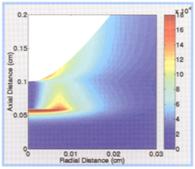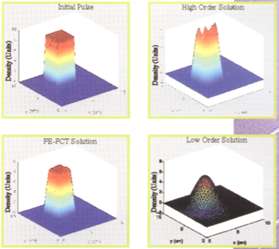| enginuity |
|
back | contents | previous | next |
Striking Research
Lightning is a spectacular demonstration of a corona discharge on a massive scale, caused by molecules of air being ionised and starting to carry a current across the gap between two conductors: the clouds and the earth. Its potentially devastating effect is well recognised, but what is less well known is the damaging effect similar corona discharges have, on a smaller scale, in many commercial applications.
Electromagnetic waves (eg. radio frequency waves, RE) are used extensively for processes such as the drying of textiles, paper and latex foam, as well as for communications (microwaves). The occurrence of corona discharges in such systems can lead to arcing, with potentially disastrous consequences such as fires or explosions. Current research being carried out at the EUG (Electricity Utilisation Group) by George Georghiou and Ricky Metaxas will allow the alleviation of such problems.

Corona discharge development in a small needle plate configuration.
George explains "Corona discharges develop extremely fast, in the order of nanoseconds. This makes it very difficult to study them experimentally, so we have turned to numerical modelling to understand their formation and thus either prevent them, or design them to be used." Corona discharges are already becoming extensively used for applications such as the reduction of CO2 emissions from exhaust gases, the treatment of polymers in the automotive industry and in semiconductor manufacturing.
Conventional finite element (FE) methods are not suitable for this type of application, so a new technique had to be developed combining FE with the flux corrected transport (FCT) method. The new numerical modelling tool, known as FEFCT, has now been successfully applied to gas discharge problems for the first time. Using this technique, the evolution of corona discharges can be followed accurately on a nano-second time scale. At the EUG, work is now being carried out on extending the technique to characterise fully developed arcs, which follow the build up of a corona.

The results of modelling the rotation of a rectangular block show the greater accuracy of the FE-ECT compared with conventional high and low order FE models.
"This type of modelling involves the solution of four equations which are coupled, giving us a very powerful tool, which is really at the cutting edge of technology," explains Ricky Metaxas "and the work will have many wide ranging applications in industry. We could even use it to model lightning strikes!"
Dr Ricky Metaxas: 01223 332680, e-mail acm@eng.cam.ac.uk
| number 8, December '99 | back | contents | previous | next |